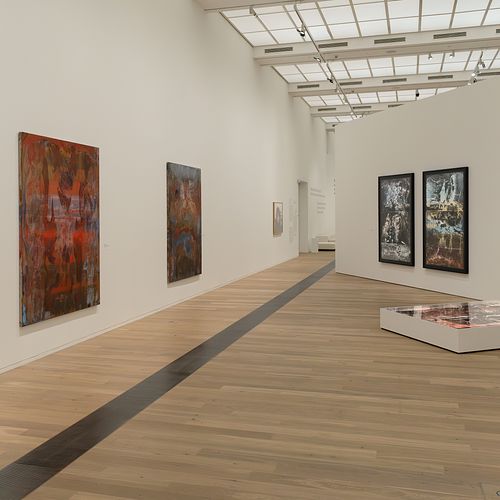AUDIO
Olga Grotova
What traces does history leave in nature? And what traces does it leave in us? The artist Olga Grotova sees individual destinies, historical events, and nature as inextricably interwoven. In her work, she traces her own roots back over several generations.
Her great-grandmother lived in the former Soviet Union and married a German who was executed in the 1930s as an enemy of the people. Shortly before the outbreak of the Second World War, his wife and daughter, Grotova’s great-grandmother and grandmother, were deported to a prison camp in Kazakhstan, and not released until 1945. The camp was hardly ever talked about. Years later, Grotova and her mother traveled to the site of the former camp and collected plants and soil samples there. The artist sees these elements as silent witnesses to the past, and as a kind of living archive. She integrates them into her works along with paint and pigments. She thus creates art that looks like painting but actually combines different techniques and materials.
In her pieces Morning Star, Ash, and Oranta, Grotova mixes pigments with particles of soil and plant samples from Kazakhstan. Again and again we can recognize shadowy impressions of the human body among the abstract forms. The latter are the outlines of her own body and her mother’s – establishing a familial connection to her grandmother and great-grandmother. The body prints are photograms – images created without a camera by placing objects on a special paper and exposing them to light.
Grotova also uses this technique in the series Sirens and the piece Eve, which you see in the display case. Here, again, the artist mixes traces of human bodies and nature. She uses paint, ash, and water to create patterns reminiscent of roots, blood vessels, and the courses of rivers. This creates an image of the deep connection between body, landscape, memory, and life story.
Grotova conceived and developed the works Eve and Noon especially for this exhibition.
Her great-grandmother lived in the former Soviet Union and married a German who was executed in the 1930s as an enemy of the people. Shortly before the outbreak of the Second World War, his wife and daughter, Grotova’s great-grandmother and grandmother, were deported to a prison camp in Kazakhstan, and not released until 1945. The camp was hardly ever talked about. Years later, Grotova and her mother traveled to the site of the former camp and collected plants and soil samples there. The artist sees these elements as silent witnesses to the past, and as a kind of living archive. She integrates them into her works along with paint and pigments. She thus creates art that looks like painting but actually combines different techniques and materials.
In her pieces Morning Star, Ash, and Oranta, Grotova mixes pigments with particles of soil and plant samples from Kazakhstan. Again and again we can recognize shadowy impressions of the human body among the abstract forms. The latter are the outlines of her own body and her mother’s – establishing a familial connection to her grandmother and great-grandmother. The body prints are photograms – images created without a camera by placing objects on a special paper and exposing them to light.
Grotova also uses this technique in the series Sirens and the piece Eve, which you see in the display case. Here, again, the artist mixes traces of human bodies and nature. She uses paint, ash, and water to create patterns reminiscent of roots, blood vessels, and the courses of rivers. This creates an image of the deep connection between body, landscape, memory, and life story.
Grotova conceived and developed the works Eve and Noon especially for this exhibition.
